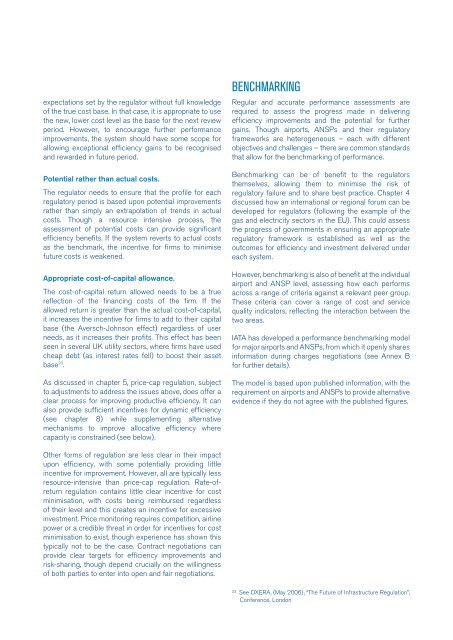Economic Regulation - IATA
Economic Regulation - IATA
Economic Regulation - IATA
Create successful ePaper yourself
Turn your PDF publications into a flip-book with our unique Google optimized e-Paper software.
expectations set by the regulator without full knowledge<br />
of the true cost base. In that case, it is appropriate to use<br />
the new, lower cost level as the base for the next review<br />
period. However, to encourage further performance<br />
improvements, the system should have some scope for<br />
allowing exceptional efficiency gains to be recognised<br />
and rewarded in future period.<br />
Potential rather than actual costs.<br />
The regulator needs to ensure that the profile for each<br />
regulatory period is based upon potential improvements<br />
rather than simply an extrapolation of trends in actual<br />
costs. Though a resource intensive process, the<br />
assessment of potential costs can provide significant<br />
efficiency benefits. If the system reverts to actual costs<br />
as the benchmark, the incentive for firms to minimise<br />
future costs is weakened.<br />
Appropriate cost-of-capital allowance.<br />
The cost-of-capital return allowed needs to be a true<br />
reflection of the financing costs of the firm. If the<br />
allowed return is greater than the actual cost-of-capital,<br />
it increases the incentive for firms to add to their capital<br />
base (the Aversch-Johnson effect) regardless of user<br />
needs, as it increases their profits. This effect has been<br />
seen in several UK utility sectors, where firms have used<br />
cheap debt (as interest rates fell) to boost their asset<br />
base 23 .<br />
As discussed in chapter 5, price-cap regulation, subject<br />
to adjustments to address the issues above, does offer a<br />
clear process for improving productive efficiency. It can<br />
also provide sufficient incentives for dynamic efficiency<br />
(see chapter 8) while supplementing alternative<br />
mechanisms to improve allocative efficiency where<br />
capacity is constrained (see below).<br />
BENCHMARKING<br />
Regular and accurate performance assessments are<br />
required to assess the progress made in delivering<br />
efficiency improvements and the potential for further<br />
gains. Though airports, ANSPs and their regulatory<br />
frameworks are heterogeneous – each with different<br />
objectives and challenges – there are common standards<br />
that allow for the benchmarking of performance.<br />
Benchmarking can be of benefit to the regulators<br />
themselves, allowing them to minimise the risk of<br />
regulatory failure and to share best practice. Chapter 4<br />
discussed how an international or regional forum can be<br />
developed for regulators (following the example of the<br />
gas and electricity sectors in the EU). This could assess<br />
the progress of governments in ensuring an appropriate<br />
regulatory framework is established as well as the<br />
outcomes for efficiency and investment delivered under<br />
each system.<br />
However, benchmarking is also of benefit at the individual<br />
airport and ANSP level, assessing how each performs<br />
across a range of criteria against a relevant peer group.<br />
These criteria can cover a range of cost and service<br />
quality indicators, reflecting the interaction between the<br />
two areas.<br />
<strong>IATA</strong> has developed a performance benchmarking model<br />
for major airports and ANSPs, from which it openly shares<br />
information during charges negotiations (see Annex B<br />
for further details).<br />
The model is based upon published information, with the<br />
requirement on airports and ANSPs to provide alternative<br />
evidence if they do not agree with the published figures.<br />
Other forms of regulation are less clear in their impact<br />
upon efficiency, with some potentially providing little<br />
incentive for improvement. However, all are typically less<br />
resource-intensive than price-cap regulation. Rate-ofreturn<br />
regulation contains little clear incentive for cost<br />
minimisation, with costs being reimbursed regardless<br />
of their level and this creates an incentive for excessive<br />
investment. Price monitoring requires competition, airline<br />
power or a credible threat in order for incentives for cost<br />
minimisation to exist, though experience has shown this<br />
typically not to be the case. Contract negotiations can<br />
provide clear targets for efficiency improvements and<br />
risk-sharing, though depend crucially on the willingness<br />
of both parties to enter into open and fair negotiations.<br />
23<br />
See OXERA, (May 2006), “The Future of Infrastructure <strong>Regulation</strong>”,<br />
Conference, London

















